How ActiveCampaign (SaaS Startup) Grew To +50,000 Customers
Summary:
[Part 1]: Why ActiveCampaign’s SaaS Messaging & Positioning Is Awesome
[Part 2]: ActiveCampaign’s Conversion Funnel Strategy & Why They Are Killing It
[Part 3]: Where ActiveCampaign Is Missing Out & My 6 Suggestions for How They Could Improve
This article is for marketers and founders at SaaS startups and software firms — or anyone who works with similar companies.
Sound good?
Let’s jump in!
Quick note before I start…
I have never worked with ActiveCampaign or founder and CEO Jason VandeBoom. Everything I describe in this article is based on my own experience as an ActiveCampaign subscriber and customer (I’ve been using their service for 3 years). I expect ActiveCampaign will constantly change its tactics (just like any company). What I describe below is what ActiveCampaign is doing today, which may change in the future.
And I love ActiveCampaign so much that I actually built better analytics & reports on top of ActiveCampaign. It’s called Wildmetrics.
[Part 1]: Why ActiveCampaign’s SaaS Messaging & Positioning Is Awesome
The first thing to say about ActiveCampaign is that they’re totally killing it.
Just last month they announced they’d crossed 50,000 customers. That’s huge for a B2B SaaS company.
Before we jump into their conversion funnel (also known as a sales funnel), there are a few things I want to show you about their strategy…
ActiveCampaign Has Great Positioning
Positioning is how a company creates a perception of uniqueness.
I really like how ActiveCampaign positions itself by saying:
“Cloud” and “integrations” = bad
“stacks” and “deep data” = good
Here’s how they talk about the “cloud” vs. their idea of “stacks”:

As someone who pays for a ton of cloud apps, this resonates with me, especially the part about paying only for what you need.
Everyone just assumes that “the cloud” is a good thing. By showing me how the cloud isn’t automatically good, ActiveCampaign creates a unique position in my mind.
This is an example of a company that’s installing beliefs in the mind of potential customers.
That’s really smart.
They’re doing the same thing with their description of “integrations” vs. “deep data”:

This resonates with me too.
Integrations are supposed to be a good thing.
But who in marketing doesn’t know the frustration of trying to connect cloud apps through Zapier or some other integration system?
Main Takeaways:
Positioning is how you create a perception of uniqueness in the mind of a potential customer
A great way to position your product is to install a belief that is “against” a mainstream idea (like the cloud or integrations)
Clear Choice of Customer Avatars
ActiveCampaign knows its customer avatars.
Check out how they’ve organized the main menu of their website

Instead of creating navigation based on features, as many SaaS companies do, ActiveCampaign’s navigation is separated by audience.
Whoever you are, you can click the link designed for you:
Bloggers
Agencies
eCommerce
SaaS
Higher Ed
You can also navigate the site by team, which is perfect for people working in bigger organizations:

Customer Success
Marketing
Sales
Once you click, you’ll land on a page designed just for you.
You can tell they’ve done their work to understand the needs of the different avatars:
Here’s the solutions page for bloggers:

And here’s the one for SaaS companies:

See how the messaging completely changes for the different avatars?
It speaks directly to the needs and wants of the person reading the page.
So simple. But also brilliant marketing.
Contrast that approach with what I see most companies do, like this page from AWeber.
It’s a completely generic page to anyone looking for an email marketing solution.

On ActiveCampaign’s site, if I’m in one of their target markets, I feel right at home — like they know me and my needs.
I feel like they get me because they’re speaking my language and talking directly to my problems and my needs.
On AWeber’s site, I have no idea.
Main Takeaways:
Create clear customer avatars, then design your messaging around them. It will make a huge positive impact on your marketing.
On your website, speak directly to the problems and needs of your avatars. Let them know you get them.
[Part 2]: ActiveCampaign’s Online Conversion Funnel Strategy Broken Down & Why They Are Killing It
Now that we’ve covered ActiveCampaign’s high-level positioning, let’s dive into the specifics of their conversion funnel.
Real quick, let’s look at their pricing strategy so you have context for their sales funnel.
As you’ll see as we dive into the details, ActiveCampaign’s entire funnel strategy revolves around getting people to sign up for a trial.
Their CTAs reflect this:

Their pricing strategy is built on retention.
For newbie marketers, ActiveCampaign is just $9/month, one of the cheapest options available.
As you gain subscribers and need more features, the service (and ActiveCampaign’s revenue) grows with you:
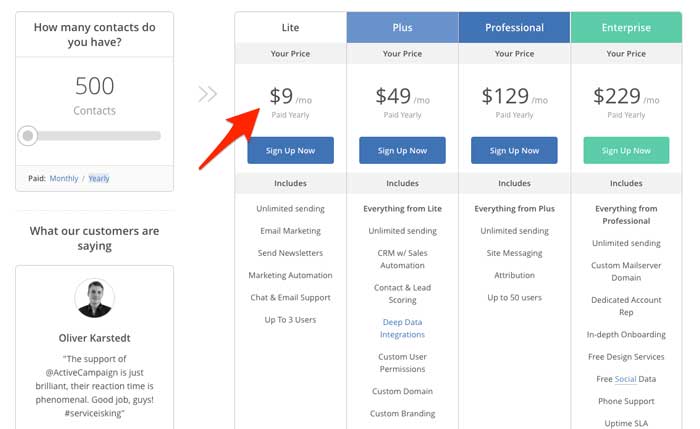
See where we’re headed?
ActiveCampaign’s Value Ladder
As a refresher, the value ladder is your big-picture zoomed-out conversion funnel strategy.
As people ascend your value ladder, they’re offered more value — and that value usually comes at a price ($).
ActiveCampaign’s value ladder is actually very sophisticated.
It looks like this:
Lead Generation: To get people in the door
Software review pages (that rank on the first page of Google)
Frontend Funnel: To qualify buyers & decrease ROI time
None (more on this in part 3 below)
Core Funnel: To sell your main product/service
ActiveCampaign’s software (with an awesome business model and pricing strategy)
Backend Funnel: To upsell existing customers & increase CLV
Continuity Funnel: To generate recurring revenue
ActiveCampaign’s SaaS business model generates monthly recurring revenue
Now let me show you how each step of the sales funnel supports these goals…
1) Lead Generation:
ActiveCampaign has a ton of activity around awareness and lead generation.
Let’s jump into each piece of their strategy.
The ActiveCampaign Blog
Blogging is an awareness strategy.
It gives ActiveCampaign a way to reach people who wouldn’t search for “ActiveCampaign” in Google — and wouldn’t click an ad for the company either.
Remember earlier when I said ActiveCampaign did a great job understanding its customer avatars?
You can see it in their blog topics:
Marketing
Strategy
Product updates
General
Small Business
Insider tips
They publish a lot — 27 articles in March 2018.
These aren’t 500-word fluff articles either.
Here’s an example of a 3,000+ word in-depth resource on copywriting, written for their marketing avatar: The Secret to Writing Great Marketing Copy is Market Research

To be fair, not all of their blog articles are this long and detailed.
But many of them are.
As a guy who has spent weeks writing one piece of epic content for a blog post, I can tell you that it takes a tremendous investment of time and effort to produce 27 quality articles in a month.
Once you get into an article, you’re met with two persistent floating CTAs, both inviting you to sign up for the newsletter.

When I entered my email to subscribe, I found it was really just another version of their main CTA: a trial signup.
To get on the “newsletter” it seems, you have to sign up for a trial account.
I couldn’t find content upgrades on any of their posts, only invitations to receive content from ActiveCampaign weekly.
(More on that later in the “missed opportunities” section.)
At the bottom of the blog posts, you see ActiveCampaign’s traditional “sign up for a trial” CTA.

Integration Marketing
Integration marketing is a way to reach users of other apps.
It’s big for ActiveCampaign. I found over 150 integrations listed on their site.

These are direct integration partners too, not just integrations through services like Zapier or If This Then That
Software Review Pages (That Rank on the First Page of Google)
Check this out.

Customer reviews are a huge part of online marketing.
Reviews are social proof.
People want to know:
Does your product work?
Do you treat your customers well?
Are people who use your product happy with it?
Notice that every listing is from a third-party review sites.
Google doesn’t return anything from ActiveCampaign’s website for the search term “ActiveCampaign review.”
That means ActiveCampaign must:
Do a good job providing the value it promises
Treat its customers well
Monitor the review sites to respond to negative reviews
As you can tell when you click through to the reviews, ActiveCampaign is very active in these forums:

Side note: if you haven’t done a Google search for “[your company] + reviews”, you should do that.
Like, now.
Events and Meetups
Conferences and meetups are a blend of marketing strategies.
They support lead generation by giving a company a way to talk to prospects.
As I’ll describe in a bit, they also support the core funnel and backend funnel.
The challenge with in-person events for lead generation is that they’re expensive and time-consuming.
Despite the cost, however, they can be a very effective way to reach clients — especially enterprise clients.
ActiveCampaign has a variety of event-marketing activities to achieve this.
They have booths at conferences all over the world to engage with people from their target markets.

They also have a brand-new 2-day conference this year in Chicago called ACTIVATE.

They’re bringing in Ann Handley and other well-known marketers as featured speakers to attract people to the event.

A 2-day conference like this is not meant to draw in the $9/month target audience.
This is for enterprise clients. ActiveCampaign target the high-dollar audience by charging $650 per ticket.
A company would need a significant marketing budget to send a manager or an employee to a conference with that high of a price tag.
And that’s exactly who ActiveCampaign is trying to attract.
For smaller businesses, ActiveCampaign also hosts meetups as another way to connect with its customer personas.

Why do events?
Because they work. Even with all the online marketing tools we have, there’s nothing quite like talking to someone face to face.
The question is just whether the ROI justifies the cost, something that will be different for every company.
The ActiveCampaign Podcast
Podcasting is usually for cultivation.
It’s a high-engagement channel, one that lets people feel like they get to know you and your company through the stories you tell.
A podcast is very different than a blog article — where readers often just skim down the page and read over the headlines.
The trick — of course — is creating a podcast people actually enjoy.
ActiveCampaign publishes its podcast “The ActiveCampaign Podcast,” weekly.
If the reviews are any indication, people really like it

If you’re wondering how a podcast is part of lead generation, it’s because people who like podcasts search for new podcasts that match their interests.
It can lead to discoveries like this one:

Here’s a customer who was using a different email service, wasn’t happy with it, and switched because he found the ActiveCampaign podcast.
That’s exactly how it’s supposed to work.
Influencers and Third-Party Online Courses
This one’s important.
If you think that lead generation is only done by people directly employed by your company, you’re wrong.
Influencers and third-party sources are a huge part of modern lead generation.
As an example, look at me!
Here’s a screenshot from a Wild Audience sales page promoting our Relationship Funnel.
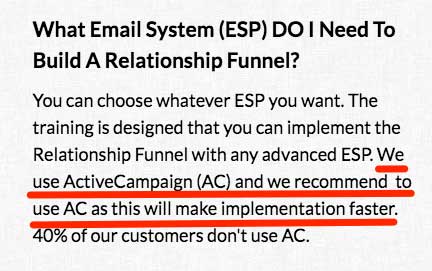
That’s us at Wild Audience driving people to sign up for the AC service — with no direct instruction from ActiveCampaign.
This is the impact of influencers.
Influencers are also on places like Udemy, teaching courses about how to get the most out of ActiveCampaign.

And on Facebook, running groups with thousands of members talking about the product.

None of these people are employees of ActiveCampaign.
But they are all driving leads to ActiveCampaign’s service.
How does ActiveCampaign get influencers to become advocates for its service?
Well, first by having an awesome product.
Second, by running a strong affiliate program

And third, by offering a certification program for consultants who want to help companies get the most from their ActiveCampaign subscription.

Taken together, ActiveCampaign is encouraging people to become more than just customers.
They’re creating a network of brand advocates.
Main Takeaways:
Lead generation strategies are a direct result of knowing your audience and defining clear customer avatars.
Employees are not the only people who influence purchase decisions. Influencers and reviews have a huge impact on sales, especially for SaaS companies.
2) Frontend Funnel:
The goal of a frontend funnel is to qualify buyers and decrease ROI time.
As far as I can tell, ActiveCampaign completely skips this step. And I find that extremely interesting.
They don’t have paid frontend products or services.
Instead, they direct all their lead generation efforts directly to their core funnel.
We’ll talk more about what they could do with a frontend funnel later in this article.
I think ActiveCampaign is definitely missing out on some things by skipping this step.
Main Takeaways:
Don’t skip the frontend funnel!
3) Core Funnel:
All the lead generation efforts ActiveCampaign point here, to the core funnel.
An Awesome Business Model and Pricing Strategy
The first thing I want to point out is that ActiveCampaign has an extremely smart pricing strategy.
I’ve read tons of resources on pricing and seen countless debates about “what should I charge” in various forums online.
The debate comes down to an argument between:
Setting a low price to attract lots of new users
Setting a high price so you only attract people who will be committed
ActiveCampaign does both.
The $9/month starting price is low enough for solopreneurs and anyone just looking to get a feel for the system.
As you grow, the price goes up, jumping to $49/month and above, levels where you’d need regular revenue from your email marketing efforts to make it worth it.

These are relatively high prices for these higher levels of service.
In other words, ActiveCampaign has a pricing strategy that allows both things to happen.
The low-price intro offer is cheap enough to attract anyone with interest.
The higher tiers are for people who are committed to the service and understand the value it delivers for their business.
Educational Content
If blogging is about awareness, educational content is about engaging people once you have their attention.
That’s why educational content is awesome for SaaS businesses.
It’s meant to help business owners and marketers understand:
The problems they face
Solutions to those problems
These are resources for customer success, not directly for lead generation. It’s a next step people can take if they’re interested in learning more — even before they sign up for a trial.
After they sign up and start using the product, that’s where educational content really fills a need, helping people answer specific questions they have about using the product.
ActiveCampaign gets this, providing a huge library of guides, videos, and webinars.
If you hear about ActiveCampaign and want to hear or see more, there’s a resource for anything you want to know

I really like their webinars — they have this idea of “success webinars” — where they talk about a specific story of how someone has used ActiveCampaign successfully.

Customer Communities
People are going to talk about your product online.
Why not own the forum or community where those conversations happen so you can be involved?
ActiveCampaign has several active communities where they cultivate these conversations. Just to show you a few of them…
There’s a support forum hosted on the ActiveCampaign website.

A closed Facebook group with almost 3,000 members.

There’s also a Slack chat group, meetups, and the events and the ACTIVATE conference we mentioned earlier.
These all provide channels to engage existing users in addition to prospects.
The Sales Follow-up Sequence
The most important part of ActiveCampaign’s core funnel is its professional sales force.
Using professional salespeople is expensive, but it’s also a great way to increase conversions. There’s really no substitute for one-on-one conversations with a real human being.
It’s been a long time since I signed up for ActiveCampaign, which made me wonder…
What does their sales process look like today? If I signed up for a new trial, what emails or phone calls would I get?
I decided to find out.
I signed up for an account with an email different than the one I already have with ActiveCampaign.
Since I already have an account, I also asked my friend Nathan — who’s based in the U.S. — to sign up for a trial account.
We both kept track of every call and email we received.
The Follow-up Sequence: 4 Phone Calls & 9 Emails Over 14 Days
Let’s take a look at what happened after Nathan signed up for an ActiveCampaign trial.
Day 1
On April 23 around noon, Nathan signed up. He immediately received a welcome email.
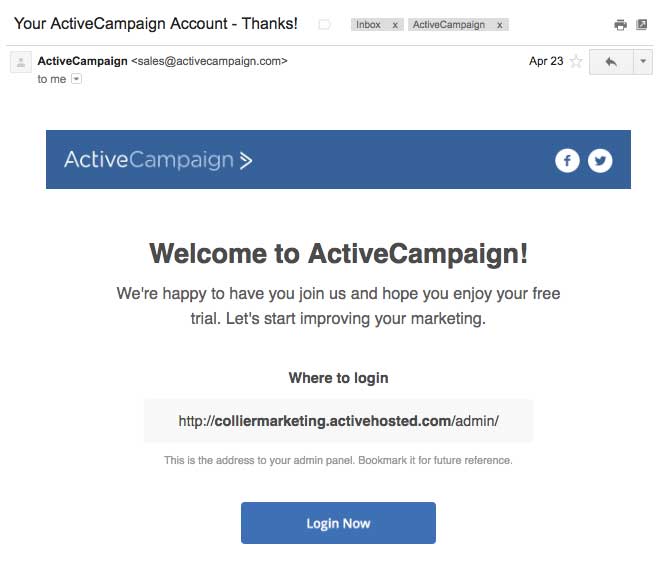
20 minutes later, he got another welcome message — this one from Jason VandeBoom’s account.

10 minutes after that, Nathan’s phone rang with a number from Chicago, where ActiveCampaign is based.
It was Ernie from the ActiveCampaign sales team, who left a voicemail wanting to know if Nathan needed any help with the new account.
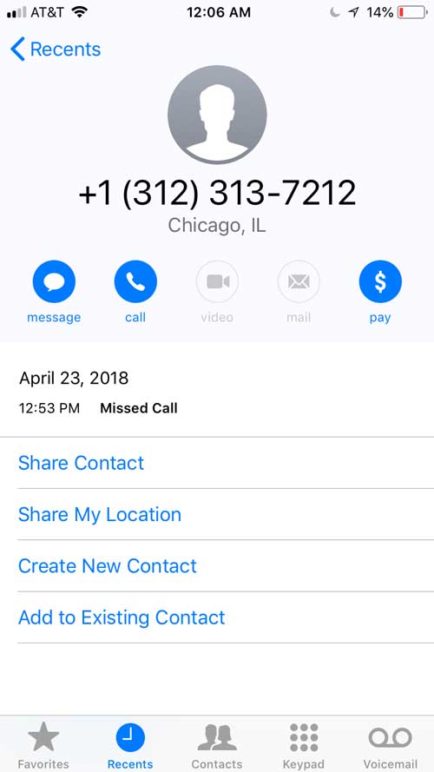
Days 2–14
Over the two weeks of the trial, Nathan received a total of 17 emails & 4 phone calls from ActiveCampaign.
Here’s what Nathan’s inbox looked on the last day of the ActiveCampaign trial:

When we looked at all the emails and phone calls in detail, they broke down like this:
8 drip emails
4 broadcast emails (announcement, new content, etc.)
4 sales phone calls
3 sales emails
1 confirmation email
1 welcome message
Drip Emails: One Every Other Day
I was expecting something a little more creative in their drip campaign, but honestly it looks like ActiveCampaign is just going with the straightforward “every-other-day” sales messages.
The drip emails started on day 2 of Nathan’s trial. They came every other day after that. Most were topical, encouraging Nathan to take action with his account.

There is so much more ActiveCampaign could be doing with this drip campaign. The big miss — in my eyes — is that these emails mostly just cover features — they don’t seek to install buying beliefs that get people engaged and keep them active until they convert.
In part 3, I’ll talk more about what they could do to install these beliefs.
If you’re interested, here are all 11 of the automated emails I received in my account:
Broadcast Emails
The broadcast emails were ActiveCampaign’s “standard” newsletter emails — with topics ranging from product announcements to information about GDPR.

Sales Phone Calls
Ernie called Nathan four times in total, leaving similar messages offering help each time he called.
We were impressed that his first call came less than an hour after Nathan’s signup — a sign ActiveCampaign has a strong lead-follow-up sequence in place.
In sequence, Ernie’s calls came on:
Day 1
Day 4
Day 9
Day 12
Here are recordings of two of those voicemails (these are actually the third and fourth calls in the sequence).
Sales Emails
Ernie followed up with a voicemail after the first three emails, giving a very professional feel to the interactions.
That was true even though Ernie’s messages are almost certainly templates he uses over and over with new trial signups.

Here are copies of all three messages:
Main Takeaways:
It’s super powerful to combine an effective drip email campaign with a direct sales approach.
A professional sales force is a major help in driving conversions — if you can afford the labor cost.
SaaS companies can create pricing models that “grow with you” to give anyone a chance to sign up.
Active customer communities = engagement = better retention.
4) Backend:
The point of the backend funnel is to upsell existing customers and increase customer lifetime value.
For SaaS companies, that often means keeping customers activated, using the software and seeing the value of the service.
In a way, reducing churn is part of the backend funnel for SaaS companies.
The support team has as much to do with this as the marketing and sales teams.
Even so, ActiveCampaign has several backend offers to upsell existing customers.
Conference
We talked about ActiveCampaign’s new ACTIVATE conference in the frontend funnel.
It costs $650 per ticket to attend, turning events marketing — usually a pure expense — into a revenue-generating activity.

Certified Consultant
Want to become a certified ActiveCampaign consultant?
It’s a great way to zero in on ActiveCampaign users as potential clients.
Cost: $2,000 (one-time fee).
Design Services
Need help with the design of your emails? ActiveCampaign has design services offering to help for $395.

Marketplace
ActiveCampaign also maintains a marketplace for third-party sellers who’ve created add-ons for the service.
This generates revenue for both the third-party seller and for ActiveCampaign.
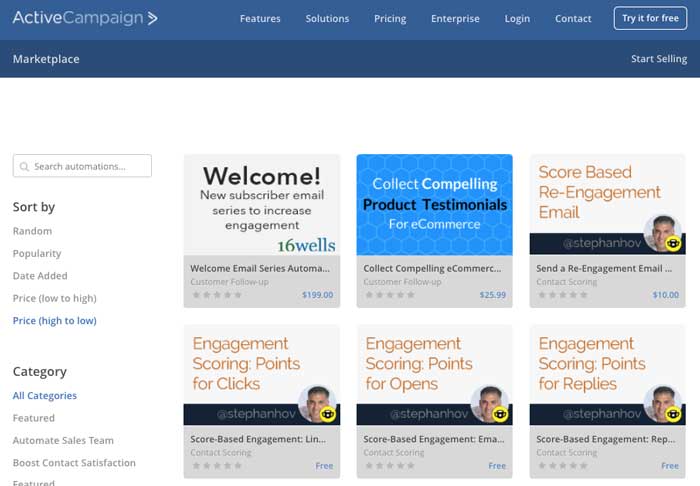
Main Takeaways:
Conferences, training, consulting, and add-ons are other ways to increase revenue and LTV for SaaS companies. They can also help improve retention.
5) Continuity
In almost every SaaS business, continuity comes from the month-to-month structure of the core offer — and ActiveCampaign is no different.
Even so, what I really like about ActiveCampaign is what we mentioned before about its business model.
As you grow and gain more subscribers, your business is probably doing well and making more revenue.
Which means when you need a bigger ActiveCampaign account, it won’t be difficult to justify the new $49/month fee.
Or the $129/month, or higher.
Main Takeaways:
In SaaS, continuity comes from the month-to-month structure of the business model.
Retention is the ultimate goal of continuity for SaaS companies.
[Part 3] Where ActiveCampaign Is Missing Out & My 6 Suggestions For How They Could Improve Their Conversion Funnel
With all that ActiveCampaign gets right, I still think they have room to improve.
All you have to do is look at what some of their competitors are doing to see what’s working in a similar space.
Specifically, I looked at:
InfusionSoft
MailChimp
ClickFunnels
Drip
ConvertKit
I also have a few suggestions from my own funnel-building experience working with SaaS companies and online course businesses.
Here are 6 conversion funnel changes I would make if I were to work with ActiveCampaign…
Change #1: Content Upgrades
I love content upgrades.
They’re a simple, effective way to double, triple, or quadruple (or more!) opt-in rates from content marketing (blogs, guides, etc.).
I use them in almost every piece of content I create (including this one!).
Here’s one from one of Wild Audience’s most popular blog posts on sales funnels:

The fact that ActiveCampaign isn’t using content upgrades at all was one of the first things I noticed when I started looking at their strategy.
Blog posts should have the main goal to get people to sign up with their email. The best way to do that is a content upgrade.
That doesn’t mean ActiveCampaign has to take away its trial offer. It could still include a trial sign-up in the top navigation or in the right banner.
Reason is that people are in different stages. Some are ready to try a new ESP like AC and this will sign-up for the trial. Others are not in the need of a new ESP as they use a different one or are just not there yet in their business journey.
Regardless of where a person, you want to start building a relationship so that once the person starts to consider ESPs, ActiveCampaign is top of mind.
A content upgrade extends the blog post with further educational content and acts as the entry point to a sales funnel. Once someone signs-up for the content upgrade, the marketing funnel kicks in and starts installing beliefs.
Change #2: Original Research
Original research is both rare and valuable.
Done right, it’s the kind of thing that gets covered in the press and linked to over and over again by people in your target market.
They’re great for lead generation, authority building, and backlinks.
One of my favorite resources is MailChimp’s annual report on email marketing benchmarks.
It’s a huge report with benchmarks for email open and click-through rates across dozens of industries — making it a fantastic resource for marketers.

It’s one of four deeply-researched resources currently available for free on the MailChimp website.
Drip uses a similar strategy with its reports on entrepreneurship and small business marketing.

As far as I can tell, ActiveCampaign isn’t currently doing original research — or at least nothing close to the scale of MailChimp and Drift.
It means they lack the big, substantive resources MailChimp and Drift have to collect email addresses and earn backlinks.
Change #3: Respect-Based Marketing (RBM)
Respect-Based Marketing (RBM) is a term we coined to describe the process we use to engage people once they’ve become aware of our brand.
It combines tried-and-true business elements like respect, relationship, trust and authority — with modern and advanced sales funnel automation to increase conversion rate.
It looks like this:
Segment new leads into buckets by asking them 5 questions during the sign-up process.
Use this data to personalize and customize your emails, website and bot messages (and any other channels you might use)
As you are more personal, people will perceive you as more relevant.
If you’re more relevant, people will engage more.
Getting the right people engaged will always result in higher sales conversions and more revenue.
Automate the whole process and turn it evergreen.
Here’s an article that was just published on Forbes that describes Respect Based Marketing and I was also interviewed by more than 20 podcasts to talk about Respect-Based Marketing. Here’s one interview I did with Ash from Productive Insights.
I have also recorded a video to walk you through the process..
To do RBM effectively, we’d need new ways to increase email signups…
Change #4: Relationship Funnel
Something ActiveCampaign is completely missing right now is any kind of content that is focused on installing buying beliefs.
All of their lead-generation work drives people directly to a 14-day trial. Once someone signs up for a trial, the email and phone call follow-up sequence kicks in.
If you look closely, the messaging in those drip emails is almost totally product focused.

See how this is all about what ActiveCampaign can do?
A Relationship Funnel is different, and — I believe — would have a big positive impact on ActiveCampaign’s results.
Relationship Funnels are based on a belief system (you can learn more about this here). We buy stuff based on beliefs… and that’s how we decide between right & wrong.
For that reason, when I help SaaS companies build Relationship Funnels, we spend a lot of time teaching those beliefs to their marketing leads, trial leads & paying customers. If we do that well, conversions go up in all stages of the process.
Here’s a simple example of how I would build a Relationship Funnel for ActiveCampaign optimized for organic traffic:
1) Create Content:
Create blog posts with content upgrades (targeted at their customer avatar) and distribute them to drive organic traffic.
2) Get Them To Sign-Up:
ActiveCampaign should be interested in two things at this point:
Getting marketing leads (people who are not ready yet for the trial)
Getting trial leads
I would use two different call-to-actions to get people to sign-up. I would always place the call-to-action for the trial visible on any page of the website.
What I would add is a content upgrade to drive marketing leads. We can then start an email sequence to install beliefs to move them towards marketing qualified and then sales qualified. See next steps..
They could also use personalization software like RightMessage to personalize the call-to-action on their blog based on what they already know about the website visitors.
Example: Show a trial CTA if visitor is marketing qualified but show a lead magnet if visitor is a first time visitor.
3) Retarget Non-Sign-Ups:
The majority of people won’t sign-up at the first time. That’s not a problem if you have a retargeting funnel installed. Two simple ways to retarget blog post readers & website visitors is through Facebook & Adwords (GDN they already do).

They can drive visitors to their trial and to lead magnets. Currently, they only drive leads to the trial as far as I saw. Lead magnets can easily be created by turning blog posts into PDFs & guides and is a great way to capture people who are not ready yet for the trial but are interested in marketing automation.
4) Relationship Building & Installing Buying Beliefs:
Ask yourself these questions:
Marketing Qualified: What does the perfect customer avatar needs to believe before she can sign-up for an ActiveCampaign trial?
Sales Qualified: What does the perfect customer avatar needs to believe before she can become a paying customer?
Customer Success: What does the perfect customer avatar needs to believe to stay an ActiveCampaign customer?
See how beliefs are part of every part of the sales cycle?
Pretty interesting, I know.
Now, how do you get people to believe certain things? You need to communicate the beliefs to them.
At Wild Audience, we build multi-channel Relationship Funnels to install beliefs. Here are some of the channels you can choose from:
Evergreen Email Sequences
Evergreen Ad Retargeting Funnels (Facebook, GDN, YouTube..)
Bot Sequences
Communities (like Facebook groups)
Phone calls
Customer Success Webinars
Etc..
Pick your channels and start communicating your beliefs to move people towards your desired outcome (marketing qualified, sales qualified, NPS scores, CLV etc..)
Installing beliefs is not about selling per se. It’s about setting the stage. Establishing a relationship, creating trust, establishing yourself as the authority and getting people to accept the desire or need of ActiveCampaign’s marekting automation software.
The bottom line: You prepare leads for the conversion event.
5) Conversion Event:
The conversion event is all about monetization. The better you do your job during the relationship builder stage (4), the higher your conversions will be on sales calls, sales pages and webinars.
What we have seen work really well, is to use evergreen conversion methods as your foundation and spice them up with timely promotions.
You could run an evergreen webinar and have a regular sales page. You jump on calls with qualified leads. And every quarter you could run a promotion (discount, free product, free onboarding coaching sessions etc..) to qualified leads (use lead scoring).
This is Relationship Funnel in a nutshell.
There is way more to it (especially in the relationship builder stage or what you do with leads who don’t initially convert) ..
But enough for now 🙂
Change #5: Frontend Product
This point builds on the Respect-Based Marketing step (change #3 above).
I’d create a $10 educational product and promote it to attract buyers. I would attach an upsell funnel to increase average order value:
Frontend offer: $10
Upsell 1: $50
Upsell 2: $150
For Wild Audience’s funnel, I did a quick check on how our frontend product is doing. For today, our average order value is $42.

That means I can spend $42 to acquire one single customer. I can then send them over to my core offer at zero cost.
If my cost to acquire one single lead (lead CAC) is below $42, I would even get paid for people just testing out my core offer. If my lead CAC is $20, I make $22 for people just giving my core a try.
That’s the magic of frontend funnels. And ActiveCampaign could do the same. They could produce educational products on how to use marketing automation to drive more revenue.
Once a prospect becomes a frontend buyer for one of ActiveCampaign’s educational products, then I’d offer them an ActiveCampaign software trial.
They could even create a frontend product that incorporates ActiveCampaign to help solve the problem the frontend product solves.
If you do this well, you breakeven on your frontend product (or even make a profit). This means you’re getting paid for people to sign up for the trial.
This is the opposite of what normally happens — where SaaS companies pay to get people to try the trial product.
Educational products work extremely well when used together with software trial signups.
Want an example?
Let’s look at ClickFunnels, which does an amazing job at this.
This is a page that offers their book — Expert Secrets — for free if you pay $7.95 shipping and handling. It’s a physical book, not just an eBook download, so the perceived value is extremely high.

That $7.95 is the first “level” of ClickFunnel’s frontend offer.
The next offer is a $37 upsell that appears after you enter your contact information, email, and address.
At this point, if you get the book or one of the three upsells, you’ll be added to their funnel to get you to try ClickFunnels’ 14-day trial.
In that way, ClickFunnels has turned its trial sign-up process (usually a money loser for SaaS companies) into a profitable step in its funnel!
Change #6: Email Sequence to Install Beliefs (Respect-Based Marketing Style)
By using tactics like content upgrades and epic research reports, I’d start collecting emails from people who like ActiveCampaign, but who aren’t yet ready to sign up for a trial. (I’d also pixel them and retarget them with ads to get as many email signups as possible.)
I’d segment people who signed up by using the same interview ActiveCampaign already has in place.
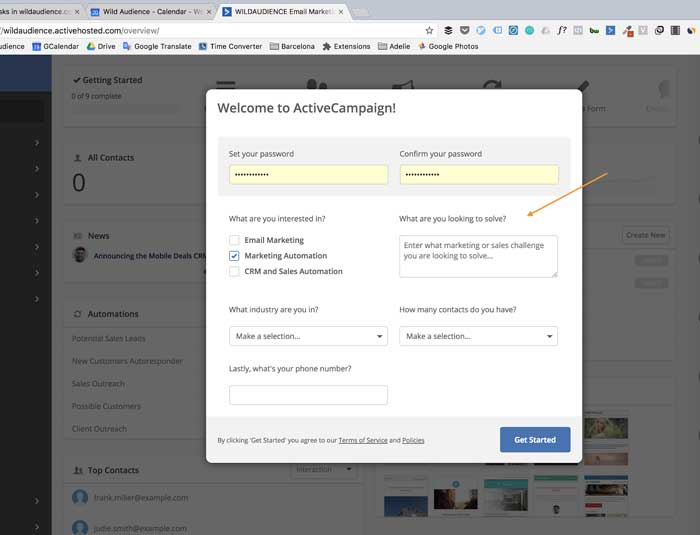
We use a similar segmentation survey here at Wild Audience.

Based on that data, I’d send them customized emails based on their answers. It would look similar to this, which is a zoomed out view of our email sequence at Wild Audience.

I’d also personalize the emails based on customer responses.
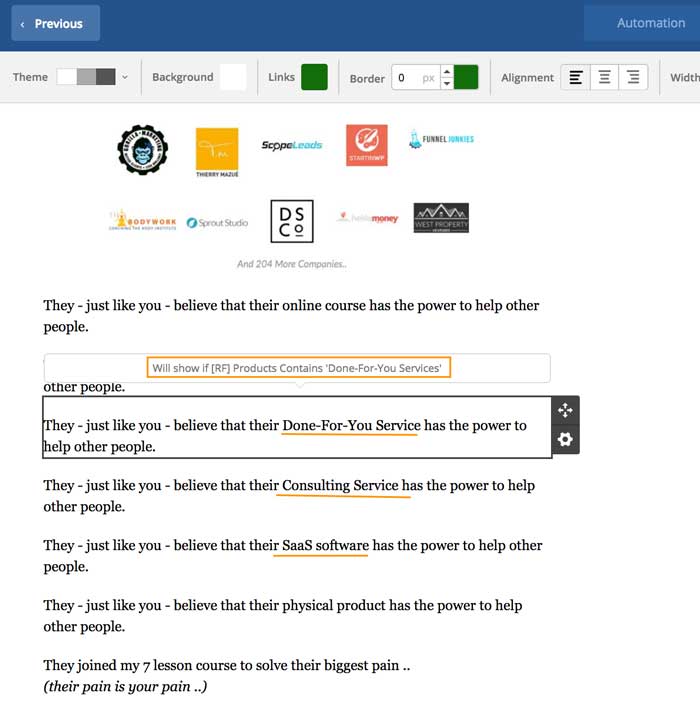
The secret to an email sequence built in the respect-based marketing style?
It doesn’t try to sell a product.
Instead, it seeks to install beliefs.
When you do this well, you create an audience of readers who are crazy-engaged.
Here are a few real-life examples showing the results people have seen using this approach.
Example 1:

Example 2:

Example 3:

For ActiveCampaign, I would create an email sequence to install beliefs such as:
Belief 1: “Email is proven to have the highest ROI”
Belief 2: “Email automation doesn’t require computer science knowledge”
Belief 3: ..
Belief 4 ..
etc.
With those beliefs installed, people would be much more likely to accept an offer for a trial — when I finally offered it to them.
If you combine that with email engagement hooks like I describe in this article you will have a winning email sequence.
Final Thoughts and Next Steps
I could say a lot more about ActiveCampaign, but to respect your time, I’ll bring this article to its end.
If you want to move on (& go deeper), take a moment to download all the resources that come with this article…Know Jason VandeBoom or want to let him know via email or Twitter that he should check out this article? You can do that here…
If you use ActiveCampaign and you want improved analytics as well as use Relationship Funnels, then I suggest to check out Wild Mail (built on top of AC).
Email Jason VandeBoom from ActiveCampaign (Click Here!)
Tweet Jason VandeBoom from ActiveCampaign (Click Here!)
Thanks!